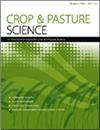稻麦系统下优化生产力和效益的耕作、作物种植和残茬保留方法
IF 1.9
4区 农林科学
Q2 AGRICULTURE, MULTIDISCIPLINARY
引用次数: 3
摘要
稻麦(RW)系统的传统耕作和作物种植方法是投入密集型的(水、劳动力和能源)。在印度西北部,每年大约有2450万吨水稻秸秆在播种小麦之前被焚烧,造成空气污染和土壤健康退化。因此,替代耕作、作物种植和残留物管理实践对于RW系统的长期可持续性是必要的。一项为期4年的实地研究评估了水稻(主地块)的四种耕作和作物种植方法以及小麦(子地块)的三种耕作和水稻秸秆管理方法对RW系统的产量、土壤肥力和盈利能力的影响。常规水田插秧稻(PTR)和常规干播稻(CTDSR)的平均产量相近。与以前的小麦作物耕作和秸秆管理方式相比,这两种处理的产量(10-16%)分别显著高于零耕DSR (ZTDSR)和ZT机插水稻在无水坑土壤中的产量(10-16%)。试验2年后,100%稻渣(+R)残留的ZT小麦(ZTW)产量显著高于不残留稻渣的常规耕作,且土壤中大量养分(钾)有效性显著提高。与ZTW+R处理相比,ZTW−R处理的小麦产量降低了15%。CTDSR-ZTW+R的体系产量最高,比传统的PTR-CTW - R高出5%,净收益增加17000公顷。本文章由计算机程序翻译,如有差异,请以英文原文为准。
Tillage, crop establishment and residue retention methods for optimising productivity and profitability under rice–wheat system
ABSTRACT Conventional tillage and crop establishment methods for the rice–wheat (RW) system are input intensive (water, labour and energy). About 24.5 million tonnes of rice residues are burnt every year on farms in north-western India before sowing of wheat, causing air pollution and soil health degradation. Therefore, alternative tillage, crop establishment and residue management practices are needed for long-term sustainability of the RW system. A 4-year field study evaluated four tillage and crop establishment methods in rice (in main plots) and three tillage and rice residue management methods in wheat (in subplots) for their effects on yield, soil fertility, and profitability of the RW system. Average rice yields were similar under conventional puddled transplanted rice (PTR) and conventional till dry seeder rice (CTDSR). Both of these treatments produced significantly greater yields (10–16%) compared with zero till DSR (ZTDSR) and ZT machine transplanted rice in non-puddled soil, respectively, regardless of tillage and straw management methods in the previous wheat crop. Wheat yields in ZT wheat (ZTW) with 100% surface retention of rice residue (+R) were significantly greater than conventional till without residue retention after 2 years of experimentation, and accompanied by significant increases in macro-nutrient (potassium) availability in soil. The ZTW−R (no residue) treatment produced 15% lower wheat yield than ZTW+R. System yield was highest in CTDSR-ZTW+R, which was 5% higher than the conventional practice PTR-CTW−R, resulting in Rs 17 000 ha−1 greater net returns.
求助全文
通过发布文献求助,成功后即可免费获取论文全文。
去求助
来源期刊

Crop & Pasture Science
AGRICULTURE, MULTIDISCIPLINARY-
CiteScore
4.20
自引率
15.80%
发文量
111
审稿时长
3 months
期刊介绍:
Crop and Pasture Science (formerly known as Australian Journal of Agricultural Research) is an international journal publishing outcomes of strategic research in crop and pasture sciences and the sustainability of farming systems. The primary focus is broad-scale cereals, grain legumes, oilseeds and pastures. Articles are encouraged that advance understanding in plant-based agricultural systems through the use of well-defined and original aims designed to test a hypothesis, innovative and rigorous experimental design, and strong interpretation. The journal embraces experimental approaches from molecular level to whole systems, and the research must present novel findings and progress the science of agriculture.
Crop and Pasture Science is read by agricultural scientists and plant biologists, industry, administrators, policy-makers, and others with an interest in the challenges and opportunities facing world agricultural production.
Crop and Pasture Science is published with the endorsement of the Commonwealth Scientific and Industrial Research Organisation (CSIRO) and the Australian Academy of Science.
 求助内容:
求助内容: 应助结果提醒方式:
应助结果提醒方式:


